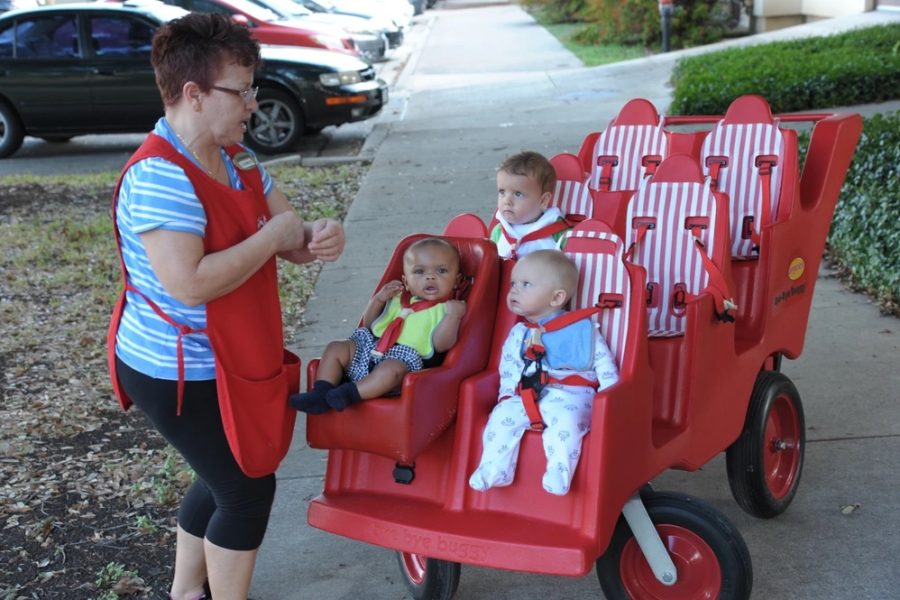Good news for Air Force families: The service is building five new child development centers (CDCs) to address unmet demands across the branch. The Air Force also rolled out new child care staffing incentives last October, which may have played a role in a recent five percent bump in staffing levels at CDCs.
Air Force spokesperson Laurel Falls told Air & Space Forces Magazine the five new facilities include:
- A CDC at Sheppard Air Force Base, Texas (under construction)
- A combination CDC/School Age Care facility at Osan Air Base, South Korea (under construction)
- Two CDCs at Joint Base San Antonio, Texas (designed and awaiting construction award)
- A CDC at Wright-Patterson Air Force Base, Ohio (designed and awaiting construction award)
When asked why those locations were chosen for new facilities, Falls said installations and Air Force major commands submit child and youth facility projects for consideration every year to address emerging needs and facility conditions. The choices were also influenced by a Child Care Capacity Initiative Cross-Functional Working Group which formed in July 2019 to analyze and propose solutions for child care challenges.
The group studied unmet child care demand across the service and came up with a prioritized list of child care facility projects that “was developed based on analysis of facility conditions and child care capacity shortages across the enterprise,” Falls said. The 2019 working group materials were internal planning documents and are not releasable, she added.
Child development centers provide child care services for infants, toddlers, and preschoolers, while school age care facilities take care of children from the start of kindergarten through the end of the summer after seventh grade, according to the Department of Defense.
Building and staffing enough CDCs to meet demand is an ongoing issue for the Air Force and the rest of the military. Parents often work odd hours in remote locations where private day care may be unavailable, overbooked, or prohibitively expensive.
“We have about an 18 percent capacity on base to take care of children that are within the age of going to childcare or school,” Chief Master Sergeant of the Air Force JoAnne S. Bass said in 2020. At the time, Bass called for building a network of options to fill that gap.
“If we don’t have that capacity on base, which, that is a separate line item that we have got to address and get after, then we’ve got to build the networks in the communities [so] that we have childcare options for families,” she said. “It is extremely hard for our single parents and dual working parents … to be able to get after that.”
Three years later, senior service leaders say building child care capacity is still top on their minds. Air Force Secretary Frank Kendall mentioned the five new facilities in June during a discussion about the all-volunteer force hosted by the Center for a New American Security.
“We’re doing a lot on the people side here, and on that list for people who are serving, child care comes very high on the list,” Kendall said, adding that housing, mental health care, and education are also priorities.
“We’re trying to get at all of those but I would put child care pretty high,” he said.
Staffing child care facilities is the biggest problem in the child care space and one that civilian parents also face, Kendall said. On the military side, the problem is exacerbated by service members’ irregular hours, especially when both parents are in uniform.
New incentives may be helping attract more talent. Starting last October, Air Force Child Development Program direct-care employees began receiving a 100 percent childcare fee waiver for their first child enrolled in an installation child development program, and a 25 percent discount for all additional children. Other child and youth program employees, such as receptionists, custodial staff, and cooks, are eligible for a 25 percent discount for each child enrolled in installation programs.
The incentives were meant to recruit and retain child care staff, and they may be making an impact: direct-care staffing level increased from 72 percent on Oct. 1, 2022 to 77 percent on June 1, 2023, Falls said.
Though it is unclear how much of that bump can be directly attributed to the new incentives, Falls reported a rise in the number of direct-care staff using the child care discount. In December 2022, 23 percent of CDC direct care staff were using the child care fee discount and in March 2023, 27 percent were using the discount, she said.
When asked if the five new centers have met their staffing goals, the spokesperson said both the new facilities at Osan and Sheppard are replacement CDCs where existing staff will transition to the new buildings, while recruitment of staff for the new CDCs in Ohio and Joint Base San Antonio will begin about 90 days before they open. The Osan project is due to finish in fiscal year 2024 and the Sheppard CDC in fiscal year 2025, but the three other project timelines will not be developed until after the construction awards are granted.
In the meantime, Kendall said in June that the Air Force is also trying to promote family child care, where certified individuals provide child care for infants through school-age children in their homes, by “giving people licenses to be able to do that and making sure compensation is adequate.”
Secretary of Defense Lloyd J. Austin III “made taking care of people one of the themes of his tenure,” Kendall added. “It’s a continuing effort to improve the quality of life of our people.”


